This is a Melcon II, a 35mm rangefinder camera made by Meguro Kōgaku Kōgyō in Tokyo Japan starting in 1957. The Melcon II was the follow up to the original Melcon camera, both of which were close copies of the Nikon S and S2 rangefinders. Unlike many copies of successful cameras where one company blatantly rips off someone else’s design, the Melcon was produced in cooperation and possibly even with the help of Nippon Kogaku, who also provided lenses for the Melcon’s Leica Thread Mount. Both the Nikon S2 and Melcon II share strong resemblances, but there are differences. The biggest is the Melcon uses the Leica Thread Mount rather than the Nikon’s bayonet mount. Other changes such as a hinged rather than a removable film door and a max shutter speed of 1/500 differentiate the two cameras.
Film Type: 135 (35mm)
Lens: 5cm f/1.1 Zunow Optical S-Zunow coated 9-elements in 5-groups
Lens Mount: M39 Leica Thread Mount
Focus: 3.5 feet to Infinity
Viewfinder: Coincident Image Coupled Rangefinder
Shutter: Cloth Focal Plane
Speeds: T, B, 1 – 1/500 seconds
Exposure Meter: None
Battery: None
Flash Mount: Cold shoe and F/X Flash Sync
Manual: None
The Voncabbage Collection
 In the fall of 2021, I had the opportunity to visit the Voncabbage Collection, one of the largest private collections of cameras in the world. The owner of this collection wishes to remain anonymous, but granted me full access to thousands of rare and unusual cameras, many of which were prototypes, one offs, or rare cameras that many collectors would go their whole lives and never see.
In the fall of 2021, I had the opportunity to visit the Voncabbage Collection, one of the largest private collections of cameras in the world. The owner of this collection wishes to remain anonymous, but granted me full access to thousands of rare and unusual cameras, many of which were prototypes, one offs, or rare cameras that many collectors would go their whole lives and never see.
Although I was able to handle and photograph any camera I wanted, when faced with literally thousands of cameras, there’s only so much time you can spend with each one. The owner let me photograph anything I wanted, but there wasn’t enough time to shoot film in any of them.
This year, I will be sharing some of the photos of cameras I took in a series of Voncabbage Collection reviews, along with whatever I could find about each one.. These reviews will be shorter, and sometimes missing things that I was unable to discover in the short time I handled them, but I’ll still do my best to find whatever I can!
History
The very first 35mm camera made in Japan was the Canon rangefinder, produced by a small company called Seiki Kogaku. Although Seiki Kogaku built the first Canon cameras, they had little experience with optical class, so they partnered with Nippon Kogaku who not only made the Canon’s lenses, but also the lens mount and the rangefinder assembly.
Around 1939, a Seiki Kogaku employee named Kumagai Genji left to form his own company called Kogaku Seiki. Kogaku Seiki was originally a service center for Seiki Kogaku, but in 1940 began working on it’s own camera, which would eventually be called the Nippon. Like Seiki Kogaku, Kogaku Seiki could not make their own lenses, so they too, used lenses made by Nippon Kogaku on the Nippon camera made by Kogaku Seiki, which was founded by an ex employee of Seiki Kogaku.
Are you still with me?
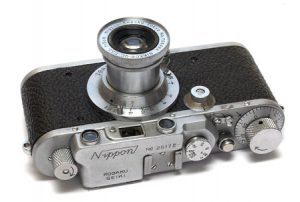
Eventually, Seiki Kogaku would change it’s name to Canon and would begin making their own lenses, ending their reliance on Nippon Kogaku. Nippon Kogaku would begin making their own cameras, with which they would include their own lenses. Kogaku Seiki would rename it’s Nippon camera to be called the Nicca, and would eventually change the entire company’s name to Nicca, but still use Nippon Kogaku Lenses.
Around 1948, Kumagai Genji would leave Nicca along with several other Nicca employees and start a series of freelance ventures with which he was linked to very similar Nicca-like cameras like the Jeicy and a camera called the Ichicon-35, which was later renamed the Honor 35.
In the early 1950s, probably 1951-52, at least one of the former Nicca employees formed a new company called Meguro Kōgaku Kōgyō to produce yet another Leica-inspired 35mm screw mount rangefinder. Who exactly started Meguro is not clear but we definitely know the company’s roots date back to Nicca. Any link to Kumagai Genji is just speculation, but another Nicca employee named Yashima Shōhei had ties to the company, so it might have been him too.
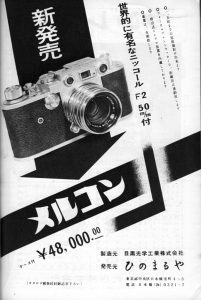
Regardless of who started Meguro, the company did exist, and began working on their new camera which they would call the Melcon. When the camera made it’s debut in 1955, the Melcon looked a lot like other Leica copies. The biggest difference was that it had a hinged back, but other changes were that it had a fixed take up spool, a different arrangement of viewfinder windows, and a top shutter speed of 1/500. The Melcon was sold only in Japan and was distributed by Hinomaruya, the same company that also distributed Nicca, further tying the two companies together.
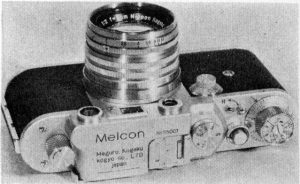
Had the history of the Melcon ended here, it would have been a short lived, but unremarkable Japanese Leica copy, not much different from several others from the same era, but in 1957, a second Melcon would be released. This new Melcon II was still a 35mm rangefinder and it still used the same Leica Thread Mount, but the design of the camera shared a similar resemblance to the Nikon S2, built by Nippon Kogaku in 1955. The same Nippon Kogaku who provided lenses to both Meguro and Nicca.
How and why Meguro decided to switch from a cosmetically similar Leica copy to one that shared several design details of a Nikon camera is unknown. Various sites online suggest the same story that perhaps Nippon Kogaku was not only okay with it, but possibly helped them build it. What role Nippon Kogaku may or may not have played in the actual development is not clear, and perhaps may never be, but I would have to agree that it seems very unlikely Meguro did this without some level of approval from Nippon Kogaku.
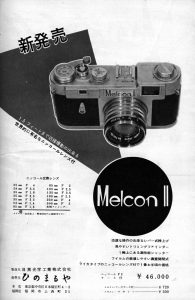
For starters, Nippon Kogaku provided the lenses that typically came with Melcon cameras. It would make no sense to rip off the very same company that you need to sell a complete camera, but also, with Meguro’s only sales channel being Hinomaruya who also sold Nikkor lenses for the much more successful Nicca, it seems very implausible that Hinomaruya would allow a brand that they distribute, to violate the design of another company whose products they also distribute.
One last thing to consider, is that between the years 1955 and 1957 when the Melcon II was likely in development, Nippon Kogaku sold far more lenses than they did cameras. Nippon Kogaku’s then current model was the Nikon S2, which had a total production of 56,715 units. The model that came before it, the Nikon S, only had 35,127 made. For comparison, between just the Nikkor-S 5cm f/1.4 and Nikkor-H 5cm f/2 lenses, nearly 200,000 were produced. Add in all of the other lenses that Nippon Kogaku had been making at the time, and it is clear that their lens output was where they saw the bulk of their profits, so for them to allow some small Japanese company to make one more camera that they could package their lenses with, was probably not a problem for them.
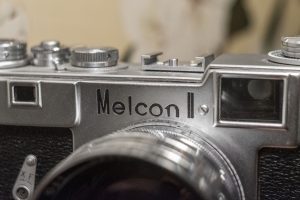
It’s also worth noting that the Melcon II isn’t really a copy of the Nikon S2 at all as there are quite a number of differences which perhaps caused Nippon Kogaku to not see it as a threat to their camera sales. While the general shape of the viewfinder window with the stepped top plate, design of the shutter speed dials, exposure counter, and film advance knob do look similar, there are more differences than similarities.
Aside from the completely different lens mount, the body of the Melcon II is rounded around the edges as opposed to angular on the Nikon, the back is hinged instead of removable, the rangefinder window is in a different location, the S2 doesn’t have a F/X flash sync lever on the front, the Nikon doesn’t have a film speed reminder dial beneath the rewind lever, the flash shoe is different, strap lugs are in a different location, the top shutter speed is only 1/500, and so on….
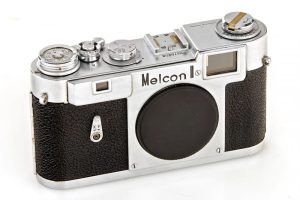
The Melcon II seems to have only been on sale for a few months in 1957 as the last known references to it appeared in Japanese language magazines in December 1957. The camera was likely never exported outside of Japan and the total production numbers are very low, probably less than 500 ever made.
After the Melcon II, as quickly and unexpectedly as Meguro came, they disappeared, never to make another camera again. There are likely many reasons the company didn’t last any longer than they did, the simplest of course was an over saturation of Japanese camera companies in the 1950s. As the market leaders like Canon, Nippon Kogaku (Nikon), Asahi Kogaku (Pentax), Chiyoda (Minolta), and Konishiroku (Konica) rose, there left little room for all of the small companies and most closed their doors never to be heard from again.
Today, low production Japanese cameras of all types are desirable by collectors for their rarity and value. The Melcon II, with it’s interesting hybrid looks of a Nikon S2 with Leica Thread Mount lenses is certainly a curiosity and very collectible. With such a low number produced, these cameras are extremely hard to come by. You could collect cameras for a lifetime and never see one in person, but if by some crazy twist of fate, if you ever do find one, even if it’s in terrible shape, do anything you can to try and bring it home, as you’ll most likely never get a second chance!
My Thoughts
Who doesn’t love a good copy! One of the appeals of the many Leica screw mount copies is that you can often find a camera with 90-95% of the performance of the real thing for a small fraction of the price. Many Japanese copies by Canon, Leotax, and Nicca are built to nearly the same quality level and in some cases, actually improve upon the original German design.
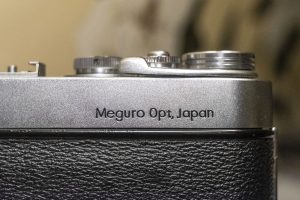
When I first became aware of a copy of the Nikon S2, I was intrigued. Although the S2 was not the pinnacle of the Nikon rangefinder line, it is my favorite user. It’s right combination of a large and easy to use viewfinder that ages well, good shutter, and excellent ergonomics make it a winner, plus that it sells for as much as half the price of the Nikon SP means there is still a chance to pick one up without breaking the bank.
Upon taking a quick look at the Melcon II, it is clear from the design of the knobs, top shutter speed dial, and stepped top plate for the viewfinder, that it’s creators had my favorite Nikon rangefinder in mind, but the more you look at it, the more it looks less and less like my favorite rangefinder.

The most obvious of which is that it doesn’t use the Nikon’s Contax-inspired bayonet mount, but rather uses the M39 Leica Thread Mount. Okay, a Nikon rangefinder copy that shoots Leica lenses is still cool, in fact, around the time of the original camera’s release, Nippon Kogaku actually worked on a LTM Nikon prototype, but it was never finished or released to the public.
Once you get past the screw mount however, the differences between the Melcon II and Nikon S2 become more and more apparent. For starters, the rangefinder window is in the wrong spot, suggesting a completely different optical assembly in there. The body is the wrong shape. Curved around the edges instead of angular like the Nikon, and of course the back is hinged, rather than removable like on all Nikons until the F2.
Keep looking and you start to see quality differences. I’ve handled at least a dozen Nikon S2s and they all have a rugged and durable body covering that never peels. The one on the Melcon is visibly peeling on nearly every edge, suggesting lower quality materials and adhesive was used.
I have no idea of what the internal construction of the Melcon is like, but externally, the metal body feels thin. Looking at the metal around the lens mount and the base plate, it bows in, suggesting a very thin gauge steel. While I didn’t have a scale handy when holding the Melcon II, I would suspect it weighs less, suggesting lower quality materials were used. Using screw mount Leica copies to compare, I’d say the overall build quality of the Melcon II is more FED or Zorki, than Canon or Nicca. I wouldn’t go as far as to say cheap, but certainly not up to the quality standards of the real thing.
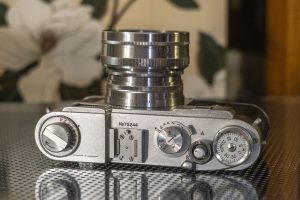
Up top, the Melcon II’s controls are in the same locations as they appear on the Nikon and most work similarly. On the left is a popup rewind knob with fold out handle, with a film reminder dial beneath it. On the Nikon, the lower dial is a flash synchro delay dial.
Next is the flash accessory shoe, two piece shutter speed dial, shutter release button with A/R collar around it, and combined film advance lever and manually resetting exposure counter. The lack of the Nikon’s complicated bayonet mount means there’s no focusing helix in the body, which unsurprisingly means there’s no fine focus wheel on the top plate. With the exception of the lack of a 1/1000 shutter speed, each of these controls does the same on the Melcon as the Nikon, although with subtle cosmetic differences.
Although I did not shoot the camera, I did wind on the camera and fire the shutter a number of times and the film advance lever was noticeably stiffer and harder to move than any of my Nikons. The sound of the shutter felt snappy though, at least suggesting it was on par with other Japanese cameras with focal plane shutters.
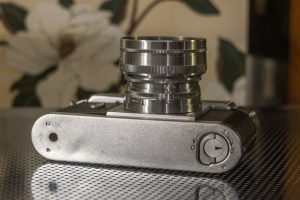
The base of the camera shows it’s screw mount Leica roots with an offset 1/4″ tripod socket on the side where the Nikon S2 has a film reminder dial, and a film door lock on the right. Despite the Melcon II having a hinged back, the door latch is still released the same as a bottom loader.
Also note on the bottom of the camera, you can see the light reflecting off a dent near the tripod socket, further suggesting the metal used in the construction of this camera was of lower quality.
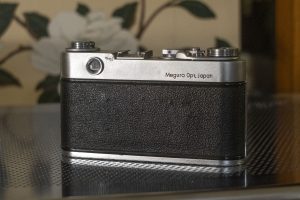
Around back, there’s not much to see other than the round eyepiece for the viewfinder and an engraved logo for Meguro Opt, Japan.
The viewfinder eyepiece is slightly smaller than that of the Nikon S2, but peering through it, I could easily see all edges of the frame even while wearing glasses. Like on other areas of the camera, the body covering on the door does not appear to be very high quality. Small bumps are visible through the body covering similar to Zeiss bumps which are common on German and some early Japanese cameras, suggesting brass rivets in the body are corroding.
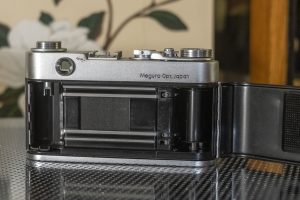
The Melcon’s film compartment is nicely appointed. With dual film rails, a cover over the sprocket shaft, and a fixed metal take up spool, this is one area of the camera that isn’t significantly worse than the Nikon. One oddity I noticed is a strip of yarn exists inside of the bottom film rail. The presence of a yarn light seal would be period correct for when the camera was made, but the fact that it does not go all the way across the film compartment is strange. I am uncertain if part of the original material was cut out, if some previous owner put this in but only on one side, or if this is how it came from the factory.
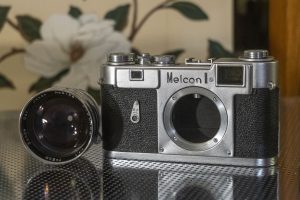
Up front, the lens unscrews exactly how any LTM camera does. You can see the round focus coupling arm at the top of the lens mount and the cloth shutter behind it. To the left of the lens mount is an F/X flash sync switch which takes the place of the adjustable dial on the original Nikon. Despite looking like a self timer lever, the Melcon II, like the Nikon S2, does not have a self-timer. Also notice the dents in the metal near the bottom corners of the lens mount.
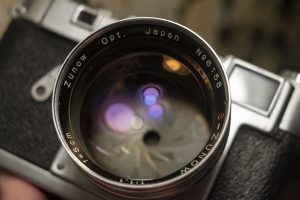
The Melcon II is a rare camera, but I probably should point out the 5cm f/1.1 Zunow lens mounted to this camera. To be clear, this was not a lens that was originally offered with the Melcon II, but in a bit of self torture, I photographed this camera with what is probably an even rarer lens in a bit of self torture you can only experience when visiting such an amazing collection of cameras.
Zunow was a highly respected maker of cameras and lenses, and this f/1.1 5cm lens was available in both M39 LTM and the Contax bayonet mount. According to this excellent review of the lens, this 9-element in 5-groups monster of a lens was first developed in 1943 during World War II, but was not available until 1953. It was made in LTM, Contax, and Nikon mounts. The lens produces very soft images, especially wide open, and is incredibly rare. Only a couple hundred were ever thought to have been made, so this combination of a Zunow lens on a Melcon II is truly a one of a kind camera.
Interestingly, Nippon Kogaku did make an f/1.1 Nikkor lens, both in Nikon and LTM mounts too, and of course I was able to play around with one in the same visit. Here are two shots of my own Nikon S2 with the f/1.1 Nikkor mounted. This really doesn’t have anything to do with the Melcon review, but it’s cool, so here you go!
As was the case with all of the camera’s in the Voncabbage collection, I only had a few minutes to photograph each one and I didn’t shoot any film through any of them. This Melcon II, despite showing some dents and age related issues such as body peeling and some chrome loss on the back plate, it appeared to be in very good condition. Everything on the camera appeared to work and the shutter speeds all fired at what sounded like “close enough” to my ear.
I have no doubt that had I been able to shoot this camera, I would have gotten good images consistent with whatever lens I had mounted to it. I likely would have said it was a good but not great Japanese rangefinder and that despite some cosmetic similarities, was not in the same league as the Nikon S2. I realize that nothing I say here will change what people say, but I feel very strongly that calling this a Nikon S2 copy is not accurate. In fact, this camera has more in common with a screw mount Leica copy just like the Melcon I, just with some Nikon-esque bits.
That said, it’s pointless for me to recommend this camera to anyone due to it’s rarity. I was happy to get a chance to experience one of these because while I am certain I could never come close to being able to afford one, even if I could, it’s just not that spectacular.
Related Posts You Might Enjoy
External Links
http://camera-wiki.org/wiki/Melcon_II
https://www.pacificrimcamera.com/pp/melcon2.htm
http://pwfukagawa.blog98.fc2.com/blog-entry-93.html (in Japanese)
http://nikonfan.cocolog-nifty.com/blog/2008/03/s2_4da6.html (in Japanese)

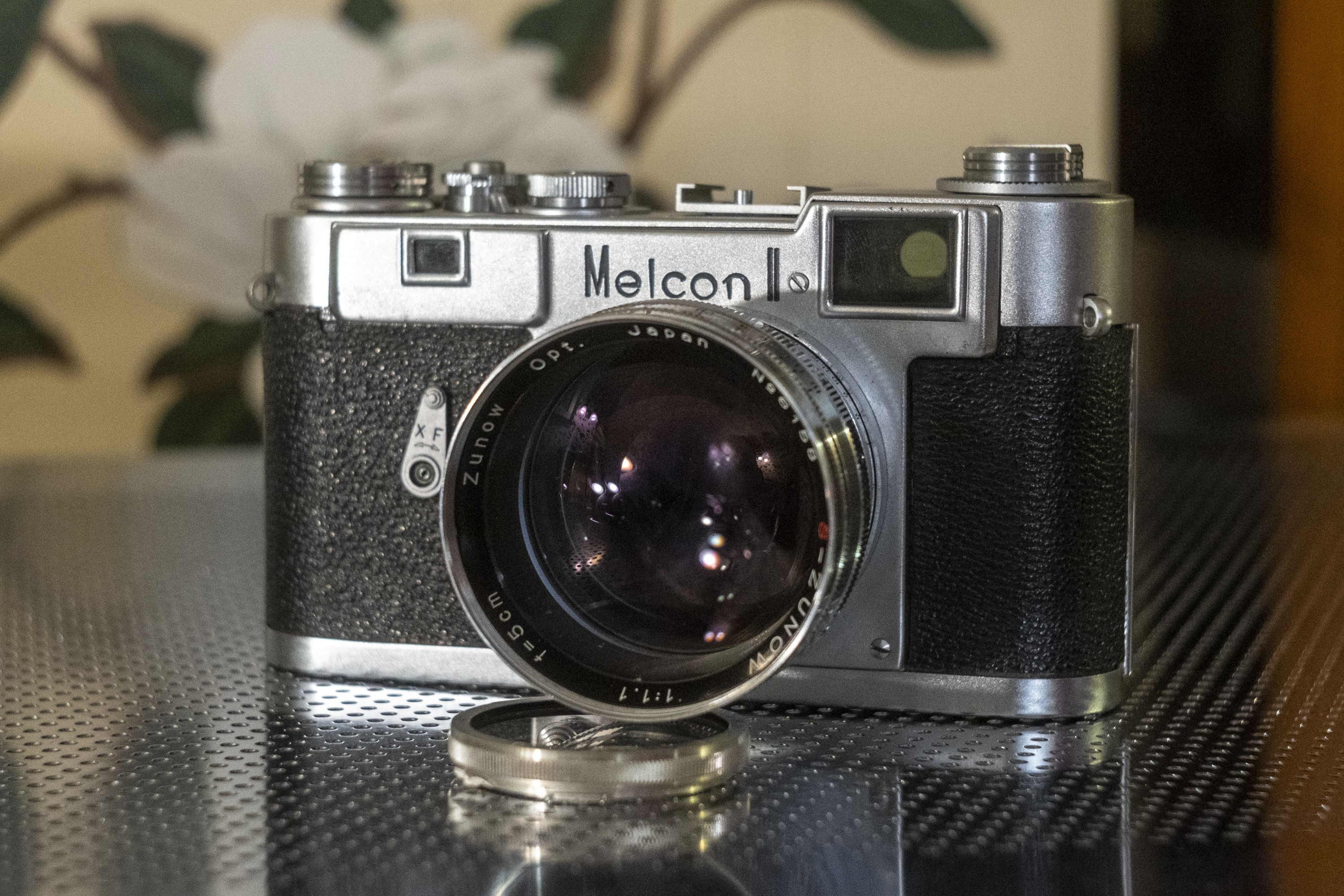
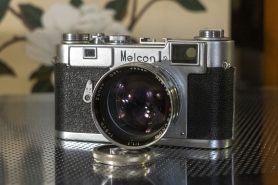
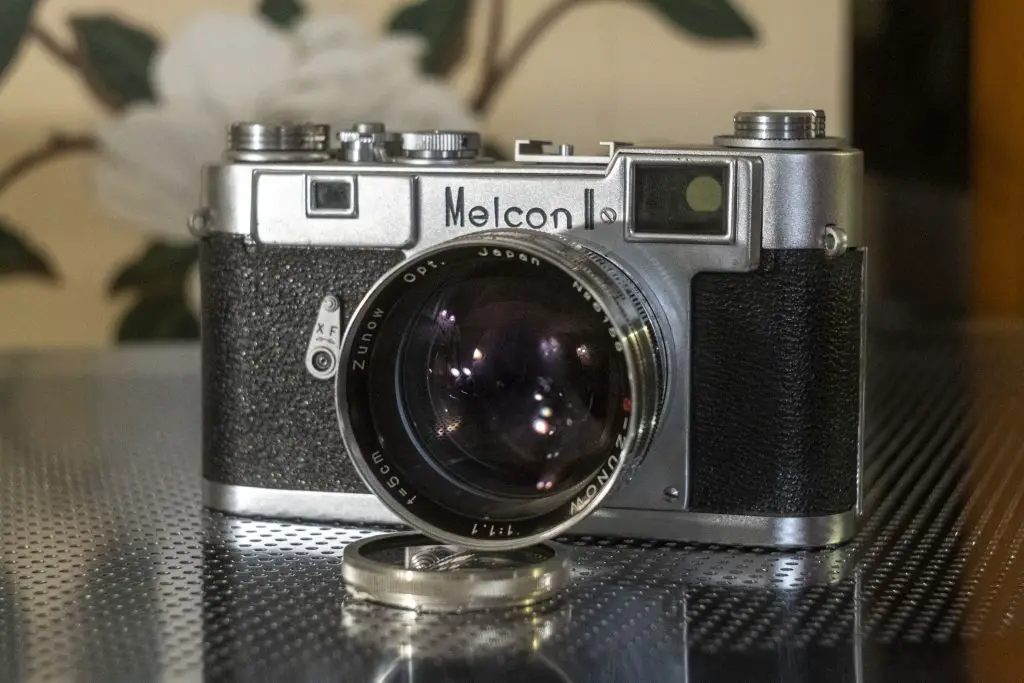
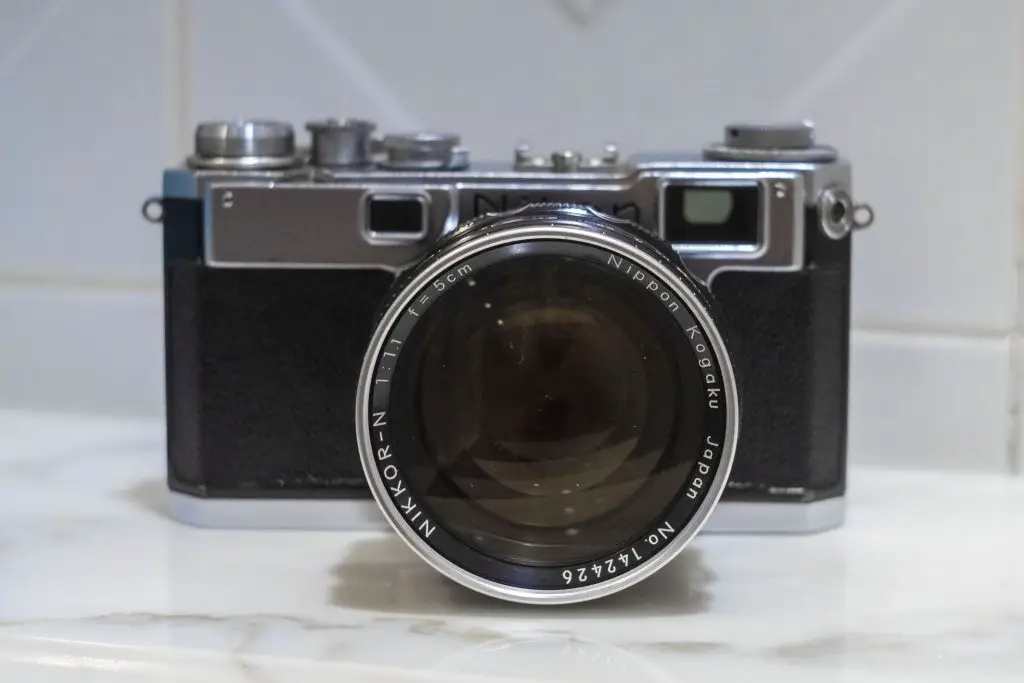
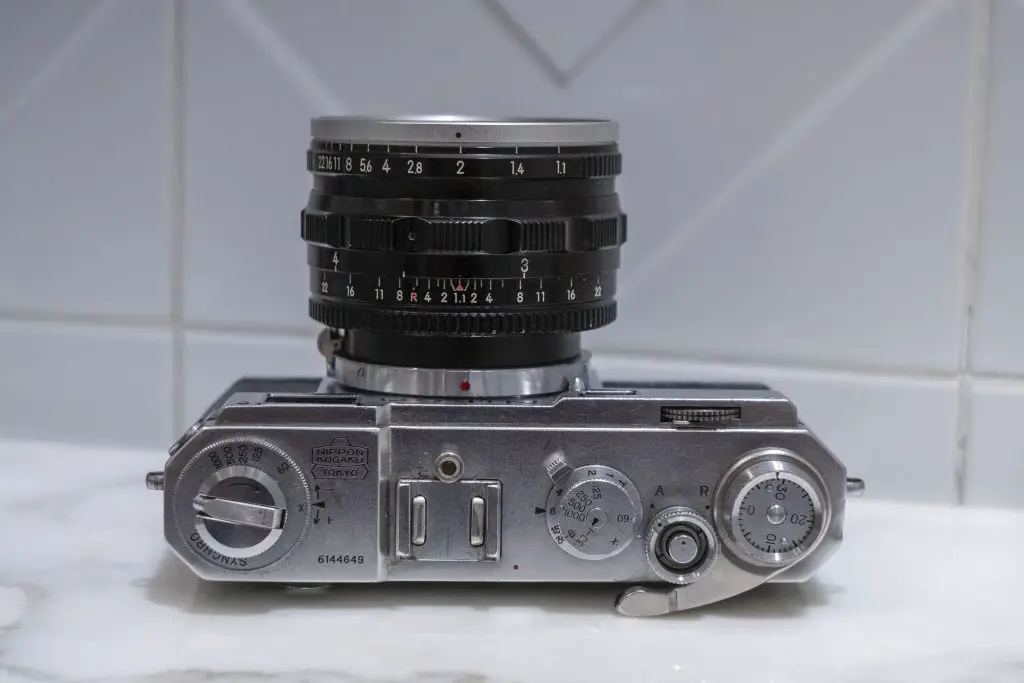
Another incredibly rare camera! Herr von Cabbage must have had remarkable skill (or luck) when he purchased these. I had a late 1950s issue of Pop Photography. Those magazines always carried fine-print ads from the big NYC and Chicago camera retailers. Olden had an advert for the Nikon S, which was available with a 1.1 Nikkor-N or a Zunow 1.1. The Zunow option cost less than the Nikkor, probably because the brand name was unknown to American buyers. Now if I can set the Wayback Machine’s dials correctly, I’ll just pop back there and buy one!
One for sale, no pictures …
https://classicconnection.com/product/melcon-ii-silver-ex-w-5cm-f2-nikkor-h-c-nippon-kogaku-lens-w-case-ex/
Very interesting camera I would like to fine a lens as described 50mm f1.1 and ltm mount. It would be an effective lens on a Leica, Leotax, Canon and others with the 39mm thread mount…. Good article… thank you! David C.
A beautiful camera and one I’ve never heard of, until now!